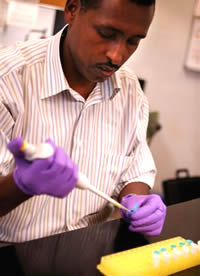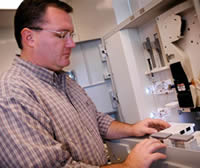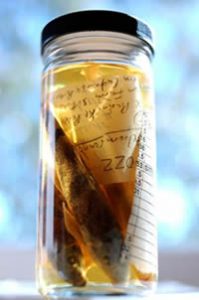Harris Lands Key Role in International Effort to Understand Gene Function
by Chris Bryant

And you thought Tuscaloosa, Ala., wasn’t an international travel destination. More than 1,000 fish carcasses from around the world – including China, Russia, Vietnam and Africa – are periodically arriving at The University of Alabama as part of a $3 million National Science Foundation-sponsored project scientists hope will ultimately reveal more about gene function in fish and, eventually, humans.
In a joint effort involving 27 scientists worldwide, UA is participating in a venture designed to define the phylogeny – the genetic relationships between organisms and how they are believed to have evolved through history – and develop classifications for a group of fish known as Cypriniformes.
“It’s not just going out and describing new species and looking at how they are related to each other – although that’s the core of it – but ultimately the applications, we hope, and the implications are much broader and can reach out to a number of different disciplines,” said Dr. Phillip Harris, assistant professor of biological sciences at UA, and one of the international effort’s principal investigators.
“Ultimately, we want to be able to look at which genes are turned on and turned off during development,” said Harris. Researchers in the project, known as the Cypriniformes Tree of Life Project, will link, for example, with other researchers participating in an effort to sequence the complete genome of the zebra fish.

“If you have an idea of the genome of zebra fish and you understand what genes are associated with turning on and turning off development of specific skeletal, muscle or nervous system characters, you can take that knowledge and apply it to other organisms, including other fish, mammals or humans,” Harris said.
When the fish carcasses arrive at UA, DNA extractions are performed in the Steve A. Johnson Molecular Systematics Laboratory. Those DNA extractions are then shipped out to four other labs around the world that are also participating in the gene sequencing.
“The goal is, for 350 species, to sequence the complete mitochondrial genome,” Harris said. “That’s 16,000 base pairs per species.” For the remaining 650 species, UA would sequence 4,000 base pairs of mitochondrial DNA plus 1,000 base pairs of a nuclear gene. Much of the sequencing work will be conducted by graduate and undergraduate students.
Cypriniformes, an order of freshwater fish, includes more than 5,500 species, described and un-described, including minnows, suckers, loaches and algae eaters. Fish fitting into these categories include goldfish and carp.

In much of the world outside North America, many of the fish in this order are consumed for food. “Having an idea of what’s out there, how these species are related to each other, and finding new species will allow us to work with those folks in aquaculture who are interested in new sources of protein for use in developing countries,” Harris said.
Common carp, for example, are frequently consumed in parts of Europe and Asia. Through the project, scientists could realize other species have the same, or better, market potential.
Harris, who has traveled to Malaysia and collected nearly 50 species of fish for the project, is working, along with his doctoral student, Kebede Beshera, closest with researchers at Saint Louis University, John Carroll University, University of Minnesota/Bell Museum of Natural History, University of South Dakota and Tulane University.
After the DNA samples are collected and tissue samples are vouchered, the carcasses will become part of UA’s ichthyological collection which, at approximately one million fish specimens, is the 11th largest in the nation. The collection serves to inventory the diversity of fish and is regularly used by scientists and other university researchers to help answer ecological and environmental questions and questions pertaining to the formation and upkeep of the existing biodiversity. “These are our records of the natural world, our repository for natural history,” Harris said.
He termed the Tree of Life project as “very ambitious.”
“We’re going to be generating a lot of new sequence data,” the UA biologist said. “There’s not any other comparable data study like this in the world for any other group of vertebrates.”
Further Reading